Distributed Magnetic Flux Density on the Cross-Section of a Transformer Core
Abstract
:1. Introduction
2. Experiment Setup
3. FEM Simulation
4. Result and Discussion
4.1. Validation of FEM Simulation
4.1.1. Comparison between Experiment and FEM Data
4.1.2. The Engineering Model
4.2. Leakage Magnetic Flux Density in the Air Gap Region
4.3. Distributed Magnetic Flux Density on the Cross-Section of the Transformer Core
4.4. The Influence of Insulation on the Distributed Magnetic Flux Density
5. Conclusions
Author Contributions
Funding
Acknowledgments
Conflicts of Interest
References
- Pfützner, H.; Shilyashki, G.; Hamberger, P.; Aigner, M.; Hofbauer, F.; Palkovits, M.; Trenner, G.; Gerstbauer, E.; Matkovic, I.; Galabov, V. Automatic 3-D building factor analyses of a grain-oriented model transformer core. IEEE Trans. Magn. 2014, 50, 1–4. [Google Scholar] [CrossRef]
- Shilyashki, G.; Pfützner, H.; Palkovits, M.; Hamberger, P.; Aigner, M. A tangential induction sensor for 3-D analyses of peripheral flux distributions in transformer cores. IEEE Trans. Magn. 2015, 51, 1–6. [Google Scholar] [CrossRef]
- Abu-Siada, A.; Budiri, J.; Abdou, A.F. Solid State Transformers Topologies, Controllers, and Applications: State-of-the-Art Literature Review. Electronics 2018, 7, 298. [Google Scholar] [CrossRef]
- Pfutzner, H.; Bengtsson, C.; Booth, T.; Loffler, F.; Gramm, K. Three-dimensional flux distributions in transformer cores as a function of package design. IEEE Trans. Magn. 1994, 30, 2713–2727. [Google Scholar] [CrossRef]
- Enokizono, M.; Todaka, T.; Kihara, K. Flux distribution in magnetic core with wound strips of laminations. J. Magn. Magn. Mater. 1992, 112, 203–206. [Google Scholar] [CrossRef]
- Enokizono, M.; Todaka, T.; Nakamura, K. Flux distribution in a wound core of a single-phase transformer. J. Magn. Magn. Mater. 1996, 160, 61–62. [Google Scholar] [CrossRef]
- Nakata, T.; Fujiwara, K.; Takahashi, N.; Nakano, M.; Okamoto, N. An improved numerical analysis of flux distributions in anisotropic materials. IEEE Trans. Magn. 1994, 30, 3395–3398. [Google Scholar] [CrossRef] [Green Version]
- Shilyashki, G.; Pfützner, H.; Hamberger, P.; Aigner, M.; Gerstbauer, E.; Palkovits, M.; Trenner, G. Pin sensor for interior induction measurements in transformer cores. IEEE Trans. Magn. 2015, 51, 1–4. [Google Scholar] [CrossRef]
- Abeywickrama, K.; Podoltsev, A.D.; Serdyuk, Y.V.; Gubanski, S.M. Computation of parameters of power transformer windings for use in frequency response analysis. IEEE Trans. Magn. 2007, 43, 1983–1990. [Google Scholar] [CrossRef]
- Kaimori, H.; Kameari, A.; Fujiwara, K. FEM computation of magnetic field and iron loss in laminated iron core using homogenization method. IEEE Trans. Magn. 2007, 43, 1405–1408. [Google Scholar] [CrossRef]
- Marketos, F.; Marnay, D.; Ngnegueu, T. Experimental and numerical investigation of flux density distribution in the individual packets of a 100 kVA transformer core. IEEE Trans. Magn. 2012, 48, 1677–1680. [Google Scholar] [CrossRef]
- Loizos, G.; Kefalas, T.; Kladas, A.; Souflaris, T.; Paparigas, D. Flux distribution in single phase, Si–Fe, wound transformer cores. J. Magn. Magn. Mater. 2008, 320, e874–e877. [Google Scholar] [CrossRef]
- Loizos, G.; Kefalas, T.D.; Kladas, A.G.; Souflaris, A.T. Flux distribution analysis in three-phase Si-Fe wound transformer cores. IEEE Trans. Magn. 2010, 46, 594–597. [Google Scholar] [CrossRef]
- Zheng, J.; Huang, H.; Pan, J.; Zhang, Y. Identification of the nonlinear vibration system of power transformers. Meas. Sci. Technol. 2017, 28, 015005. [Google Scholar]
- Bai, B.; Bing, X.; Jin, L. An analysis to force received in transformer core under DC bias conditions. In Proceedings of the 2011 International Conference on Electrical Machines and Systems, Beijing, China, 20–23 August 2011. [Google Scholar]
- Zhafran, Z.M.; Isa, M.; Hashim, U.; Rahim, A.R.A. Analysis of parasitic components with various sizes of coils in high frequency micro-fabricated transformer. In Proceedings of the 2015 2nd International Conference on Biomedical Engineering, Penang, Malaysia, 30–31 March 2015. [Google Scholar]
- Hu, D.; Sheng, J.; Ma, J.; Yao, L.; Li, Z.; Hong, Z.; Jin, Z. Characteristic Tests and Electromagnetic Analysis of a Novel HTS Partial Core Transformer. IEEE Trans. Appl. Supercond. 2016, 26, 1–5. [Google Scholar]
- Du, X.; Pan, J.; Guzzomi, A. Modeling the Hysteresis Characteristics of Transformer Core under Various Excitation Level via On-Line Measurements. Electronics 2018, 7, 390. [Google Scholar] [CrossRef]
- Ayachit, A.; Kazimierczuk, M. Sensitivity of Effective Relative Permeability for Gapped Magnetic Cores with Fringing Effect. IET Circuits Devices Syst. 2017, 11, 209–215. [Google Scholar] [CrossRef]
- García Espinosa, A.; Riba Ruiz, J.R.; Cusido Roura, J.; Romeral Martínez, J.L.; Ortega Redondo, J.A. Dynamic evaluation of fringing flux in linear electromechanical devices. J. Electr. Eng. 2010, 10, 1–8. [Google Scholar]
- Roque, A.; Sousa, D.; Margato, E.; Machado, V.; Sebastiao, P.; Marques, G. Magnetic Flux Density Distribution in the Air Gap of a Ferromagnetic Core with Superconducting Blocks: 3D Analysis and Experimental NMR results. IEEE Trans. Appl. Supercond. 2015, 25, 1–9. [Google Scholar] [CrossRef]
- Liu, M.; Hubert, O.; Mininger, X.; Bouillault, F.; Bernard, L. Calculation of magnetostriction induced deformations in grain oriented and non-oriented silicon iron transformer cores thanks to an imposed magnetic flux method. In Proceedings of the Compumag 2015, Montreal, QC, Canada, 28 June–2 July 2015. [Google Scholar]
- Hahne, P.; Dietz, R.; Rieth, B.; Weiland, T. Determination of anisotropic equivalent conductivity of laminated cores for numerical computation. IEEE Trans. Magn. 1996, 32, 1184–1187. [Google Scholar] [CrossRef]
- Zheng, W.; Cheng, Z. An Inner-Constrained Separation Technique for 3-D Finite-Element Modeling of Grain-Oriented Silicon Steel Laminations. IEEE Trans. Magn. 2012, 48, 2277–2283. [Google Scholar] [CrossRef]

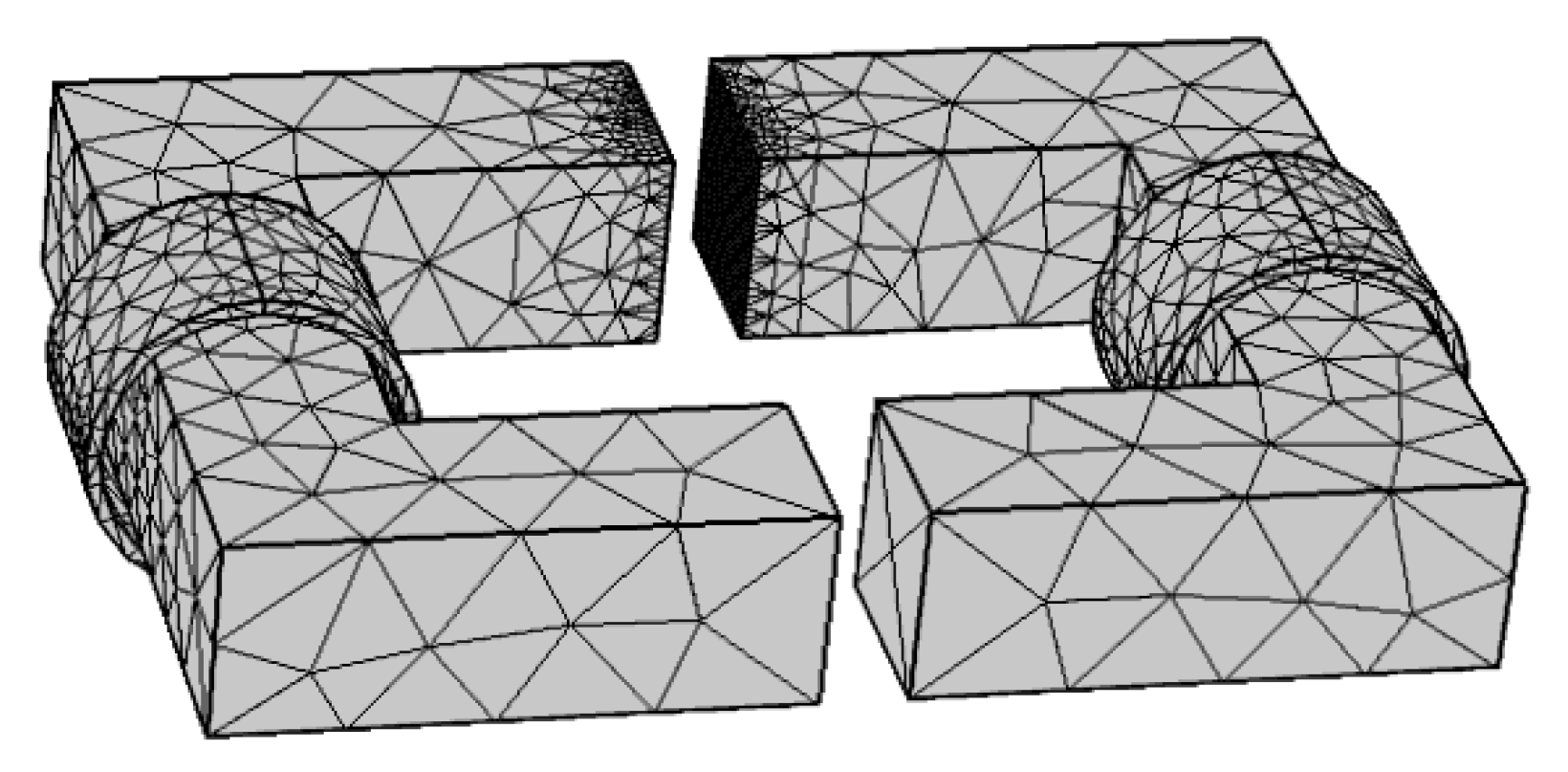


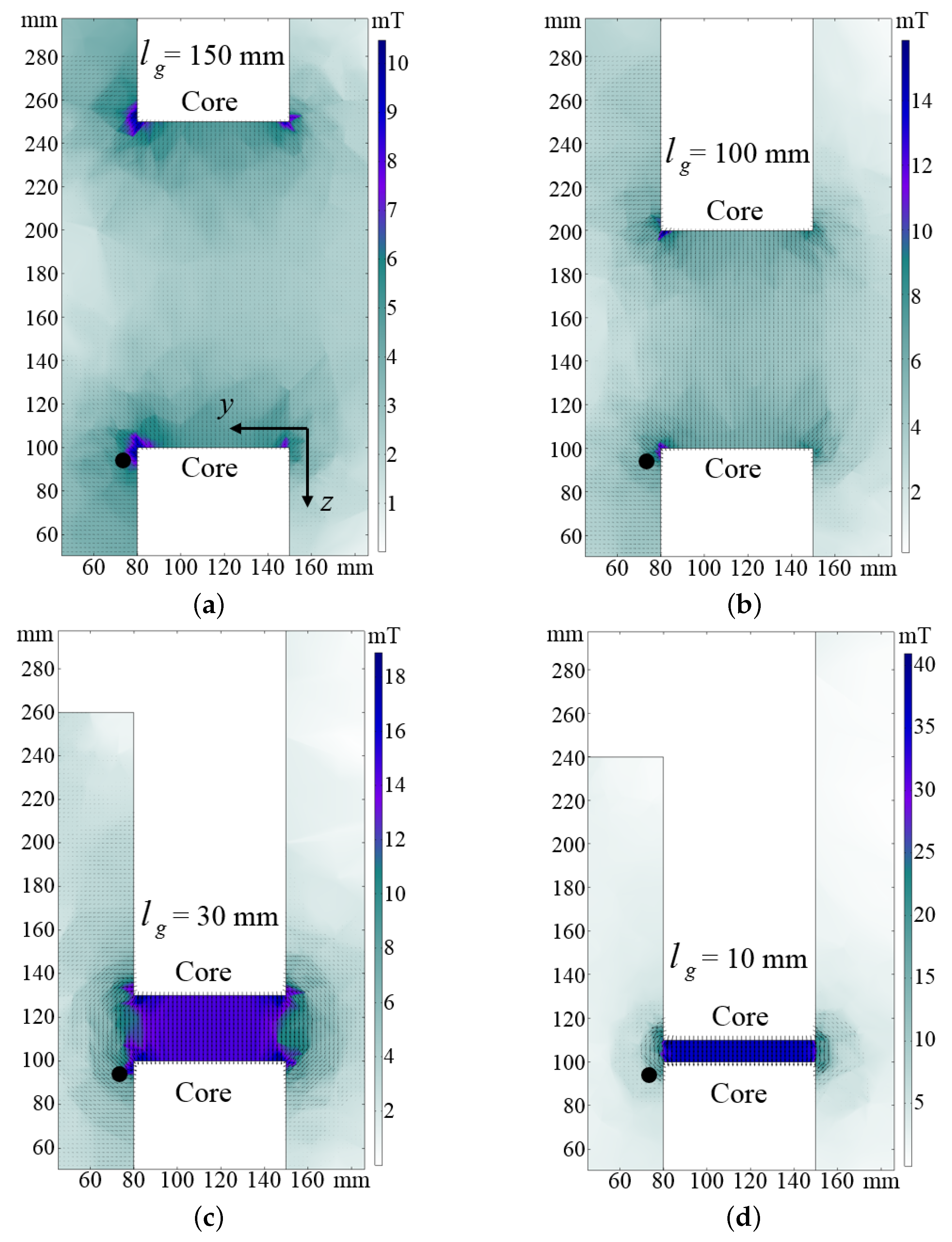
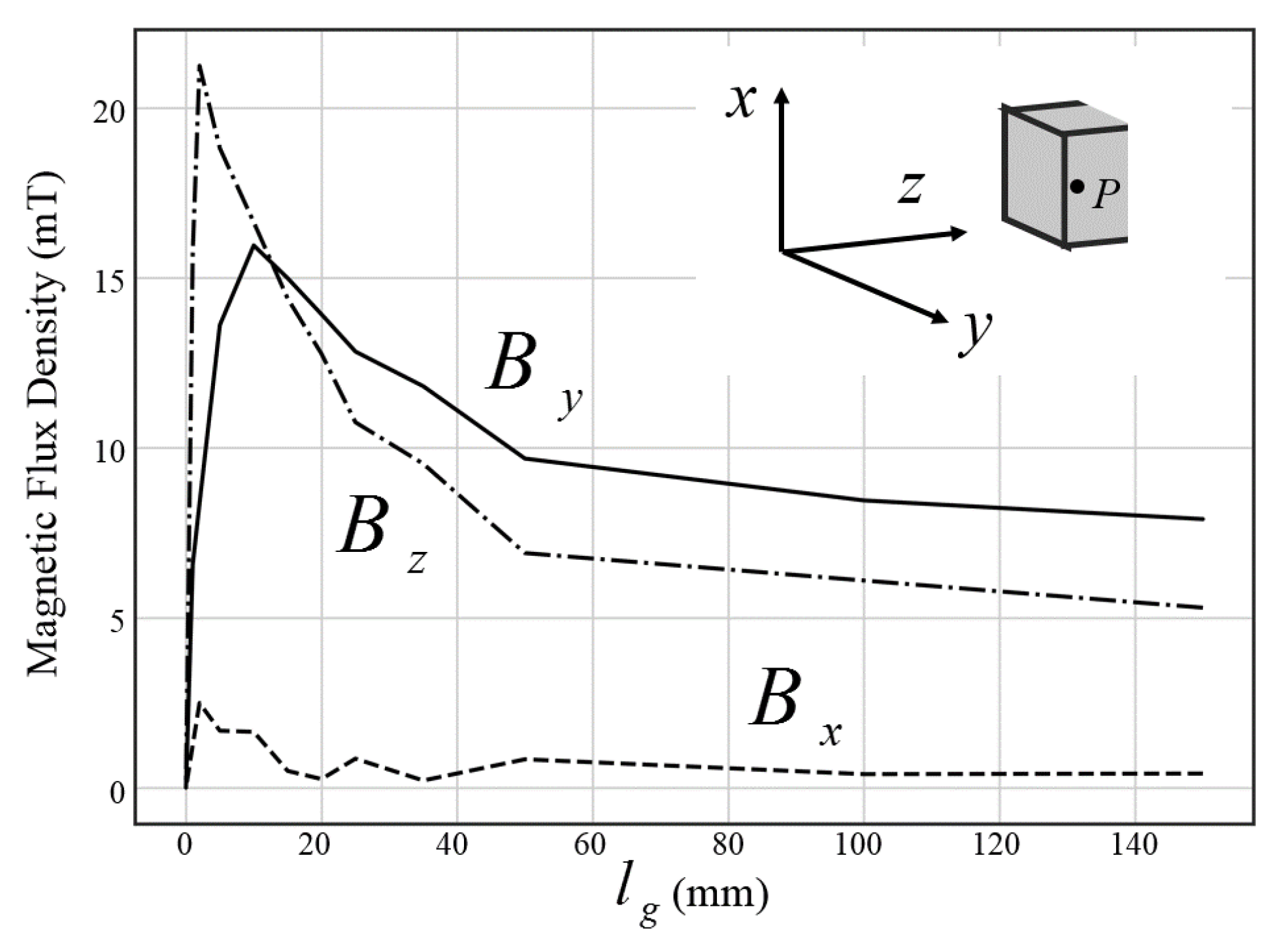

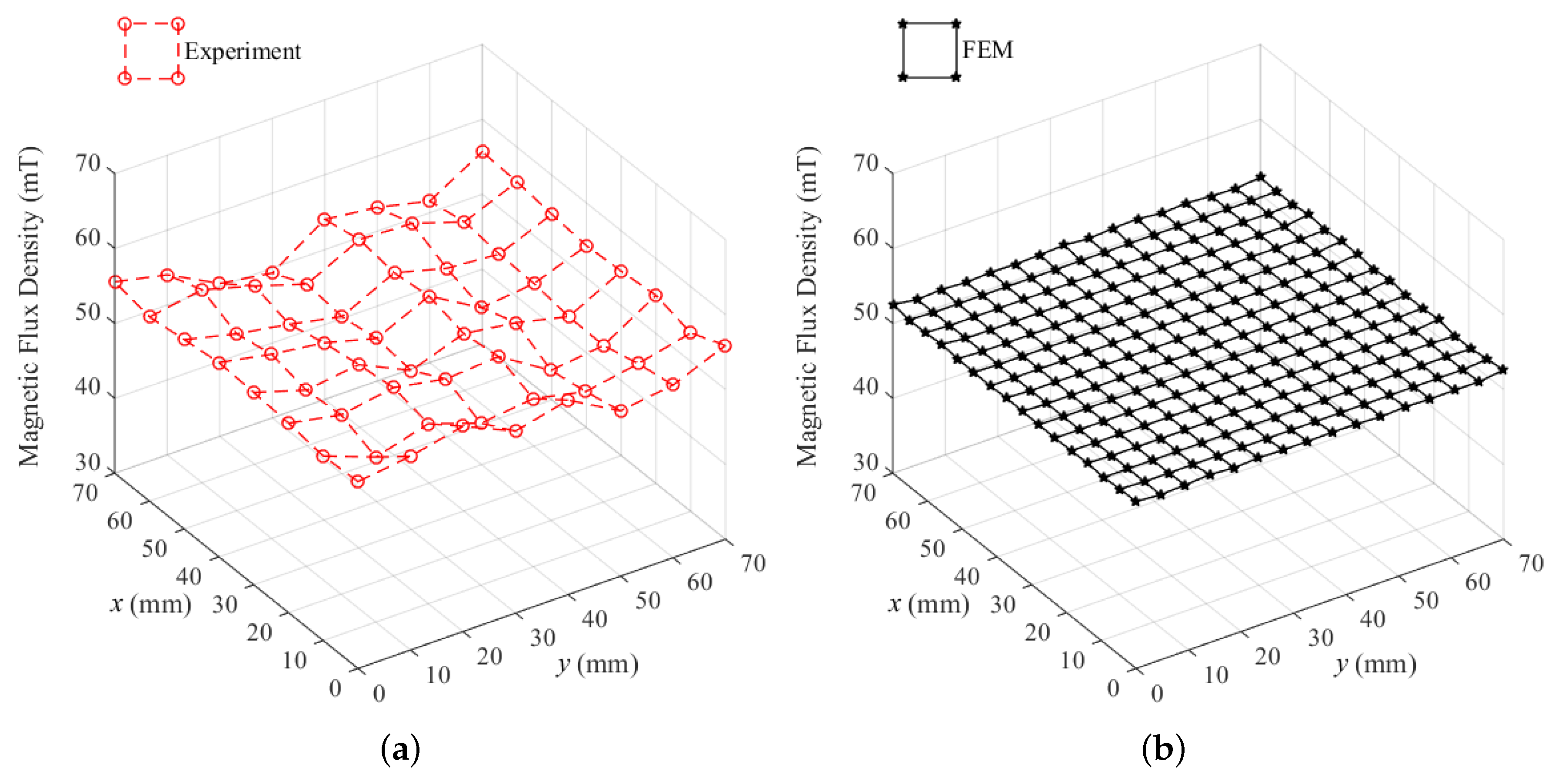
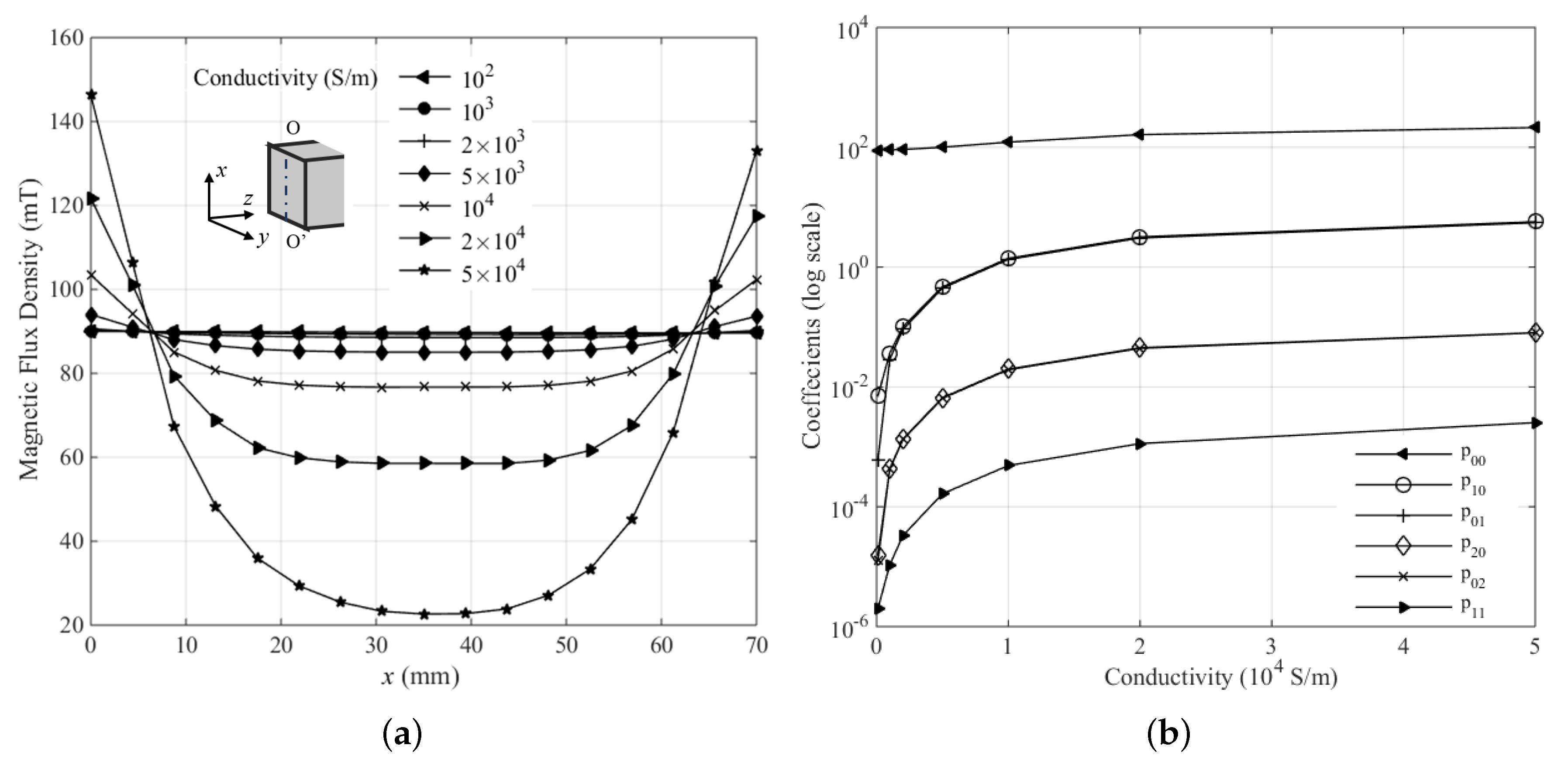
| Experiment | 342.14 | 0.54 | 4.53 |
| FEM | 301.95 | 0.47 | 3.44 |
| Coefficients |
© 2019 by the authors. Licensee MDPI, Basel, Switzerland. This article is an open access article distributed under the terms and conditions of the Creative Commons Attribution (CC BY) license (http://creativecommons.org/licenses/by/4.0/).
Share and Cite
Li, L.; Du, X.; Pan, J.; Keating, A.; Matthews, D.; Huang, H.; Zheng, J. Distributed Magnetic Flux Density on the Cross-Section of a Transformer Core. Electronics 2019, 8, 297. https://doi.org/10.3390/electronics8030297
Li L, Du X, Pan J, Keating A, Matthews D, Huang H, Zheng J. Distributed Magnetic Flux Density on the Cross-Section of a Transformer Core. Electronics. 2019; 8(3):297. https://doi.org/10.3390/electronics8030297
Chicago/Turabian StyleLi, Lingzhi, Xuhao Du, Jie Pan, Adrian Keating, David Matthews, Hai Huang, and Jing Zheng. 2019. "Distributed Magnetic Flux Density on the Cross-Section of a Transformer Core" Electronics 8, no. 3: 297. https://doi.org/10.3390/electronics8030297
APA StyleLi, L., Du, X., Pan, J., Keating, A., Matthews, D., Huang, H., & Zheng, J. (2019). Distributed Magnetic Flux Density on the Cross-Section of a Transformer Core. Electronics, 8(3), 297. https://doi.org/10.3390/electronics8030297





